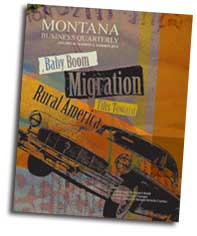MONTANA BUSINESS QUARTERLY
Volume 48, Number 2, Summer 2010 |
|||
 |
Baby Boom Migration Tilts Toward Rural Americaby John Cromartie and Peter Nelson |
||
As Americans age, their likelihood of migrating, their reasons for moving, and their destination choices shift dramatically. Baby boomers (born between 1946 and 1964) are entering a stage when moves to rural locales increase, especially to areas with scenic amenities and lower housing costs. | |||
Recession Throws Migration Trends a Curve Ballby Patrick M. Barkey |
Trends in population migration took a pause during the nation's worst recession since the Great Depression, recent data from the U.S. Census Bureau show. That is particularly true for the year 2009 in some of the traditionally faster growing parts of Montana. |
The University of MontanaGrowing Montana's Economyby Patrick M. Barkey |
The University of Montana is a major generator of economic wealth throughout the state of Montana. Its presence in the state economy makes the economic pie significantly bigger. Our analysis indicates that 9,700 jobs, more than $1 billion in after-tax income, and almost $200 million in state tax revenues are attributable to the presence of UM-Missoula in the Montana economy. |
The New Health Care LawMontana's First Stepsby Gregg Davis and Jerry Furniss |
The new health care legislation is slated to change the health care marketplace gradually through numerous provisions. Three of these provisions are already out of the starting gate: tax credits for small employers offering health insurance to their employees; the closing of the 'donut hole' for Medicare Part D enrollees; and the creation of a state high-risk pool for individuals who have been without health care insurance for at least six months. |
Economic Costs of Alcohol-Related Vehicle Crashes in Montanaby Steve Seninger |
Five people are injured or killed each day in Montana because of alcohol-related vehicle crashes. These accidents cost Montanans $621,000 per day and more than half a billion dollars per year in medical costs, lost wages, and lost productivity. |

